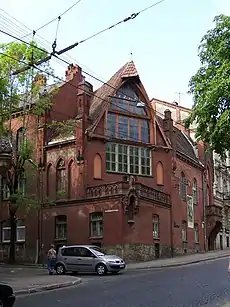Julian Oktawian Zachariewicz-Lwigród
Julian Oktawian Zachariewicz-Lwigród (July 17, 1837 – December 27, 1898), commonly referred to as Julian Zachariewicz, was a Polish architect and renovator, father of Alfred Zachariewicz. Zachariewicz was a graduate of the Royal Polytechnic Institute in Vienna,[1] and a professor and rector (1881–1882) of the Lemberg Polytechnic.[2]
Julian Zachariewicz | |
|---|---|
 Marble bust of Prof. Julian Zachariewicz located in the foyer of Lviv Polytechnic by Juliusz Wojciech Bełtowski | |
| Born | July 17, 1837 |
| Died | December 27, 1898 (aged 61) |
| Nationality | Polish |
| Occupation | architect |
| Practice | Lviv Polytechnic |
| Buildings | Main building of the Lviv Polytechnic Iași railway station Galician Savings Bank in Lviv |
Life
He was born in Lemberg, Austrian Empire (Polish: Lwów, now Lviv, Ukraine) to a Polish family. He graduated from the Vienna University of Technology. As a qualified engineer, he held until 1870 numerous positions in the Austrian State Railways. In 1871, he was proposed the post of director of the newly-established Faculty of Civil Engineering at the Lviv Technical Academy (now Lviv Polytechnic). As a consequence, he returned to Lviv and worked as professor at the academy and was appointed dean of the Faculty of Civil Engineering. Between 1877–1878 and 1881–1882 he served as rector of the Lviv Polytechnic. In 1877, he received Austrian nobility "Ritter" title (Grade II) with the predicate "von Lwigród". He designed the main building of the Lemberg Polytechnic as well as a separate building of the Faculty of Chemistry. The main building of the polytechnic, known as the "Mother of Polish Technical Universities", was designed in the then-fashionable eclectic Neo-Renaissance style and was preceded by a number of journeys across Germany and Austria made by Zachariewicz during which he became familiarized with all the newest innovations relating to the construction of this type of buildings. He also designed numerous public buildings and private residences including the Iași railway station (1869–70), the Czernowitz Synagogue,[1] the Galician Savings Bank in Lviv, Church of Franciscan Sisters in Lviv, Jan Styka's villa, and the Tyszkiewicz Villa in Vilnius. He also carried out the renovation of the Church of the Holy Family in Tarnów as well as controversial renovations of the Church of Our Lady of the Snow in Lviv and the Church of John the Baptist in Lviv.
In 1894, he supervised (alongside Franciszek Skowron) the construction of more than 100 pavilions for the General National Exhibition in Lviv.[3] He is the author of the book Zabytki sztuki w Polsce (Works of Art in Poland) published in 1895.[4][5][6]
He died in Lemberg and was interred at the Lychakiv Cemetery.
Gallery


 Main building of Lviv Polytechnic
Main building of Lviv Polytechnic Galician Savings Bank, Lviv
Galician Savings Bank, Lviv St. Mary's Church in Stryi
St. Mary's Church in Stryi Psary Palace
Psary Palace Jan Styka House, Lviv
Jan Styka House, Lviv Zachariewicz coat of arms
Zachariewicz coat of arms
References
- Prokopovych, Markian (2009). Habsburg Lemberg: Architecture, Public Space, and Politics in the Galician Capital, 1772-1914. Purdue University Press. pp. 111, 114, 131. ISBN 978-1-55753-510-8.
- "Zachariewicz-Lwigród Julian Oktawian". Internetowa encyklopedia PWN (in Polish). Archived from the original on 2008-03-10. Retrieved 2007-04-24.
- "STRYISKYI PARK". Retrieved 22 December 2020.
- "Julian Oktawian Zachariewicz – zapomniany ojciec polskiej architektury". Retrieved 2019-07-27.
- "Znaczenie działalności profesora Juliana Zachariewicza w popularyzacji sztuki witrażowej we Lwowie. Realizacje firmy „Tiroler Glasmalerei und Mosaik Anstalt" na terenie Galicji Wschodniej". Retrieved 2019-07-27.
- "ARCHITECTURAL EDUCATION AT LVIV POLYTECHNIC DURING THE INTERWAR PERIOD" (PDF). Retrieved 2019-08-06.
| Wikimedia Commons has media related to Julian Zachariewicz. |